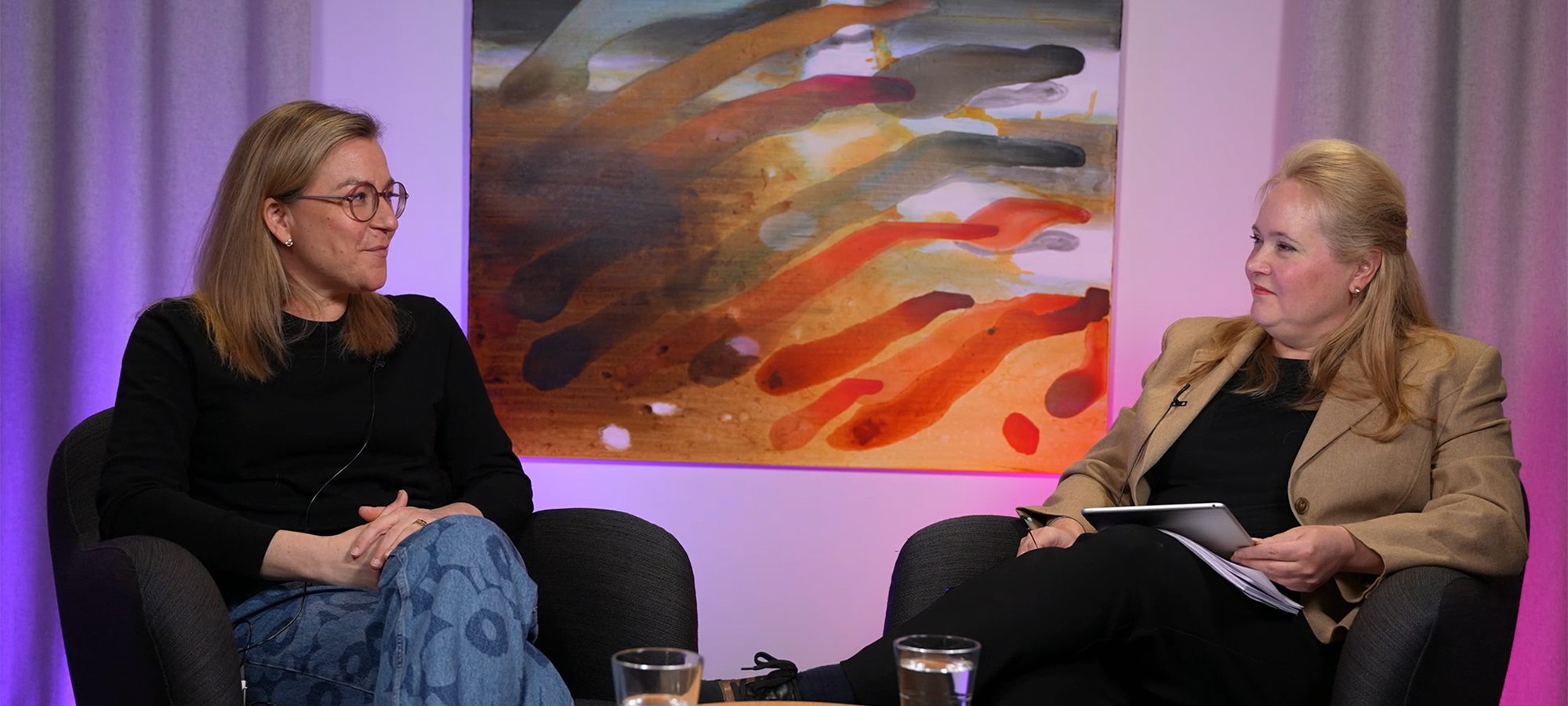The Wall Street Journal reviewer was not impressed. In his reading, I was a rather hysterical woman, one who likes to cherry-pick facts and write terrible, melodramatic prose, while praising a nation that collects just a little less in taxes than Cuba. My book was allergic to nuance, and I myself was in need of Xanax, prone to hyperventilating, and likely to ignore any inconvenient facts that didn t support my view. The editors of the paper had titled the review Stockholm Syndrome and illustrated it with a photo of members of a Swedish left-wing party marching on May Day, waving their red flags in the air.
You might think I had written a book praising socialism, or communism, or whatever you might want to call it, or perhaps a book expressing the views of a raging far-left feminist, or maybe a work in some new genre of red brigade chick lit — the kinds of things that would surely raise the ire of opinion writers at a newspaper like the Wall Street Journal. But as far as I knew, I had done nothing of the sort. In fact, as far as I knew, I had written a fairly straightforward nonfiction book about the differences in ordinary people’s lives in the United States and the Nordic nations, and detailing how the Nordic countries support the freedom of their citizens, their businesses, and their markets. I had interviewed families and experts in several countries, waded through hundreds of academic studies, and weaved it all together with my own experiences of living and working in the United States and in Finland. I thought I had gone out of my way providing evidence and arguments that demonstrated that the Nordic nations are capitalist — not socialist — countries, and to praise the quest for individual freedom, equality of opportunity, and a high quality of life for all countries.
The book included chapters on family policies, education, health care, entrepreneurship, success, and happiness. I had interviewed representatives of highly profitable companies such as Denmark’s pharmaceutical giant Novo Nordisk, Finland’s mobile game phenomenon Supercell, and Sweden’s fashion trendsetter Acne. I had talked to economists, including the Finnish MIT professor Bengt Holmstöm, who went on to receive the Nobel Prize in economics a few months after my book was published. And I had studied it all through the lens of how capitalist countries can use smart policies to support everyone’s ability to fulfill their potential and become independent, self-supporting citizens. Of course, I had also suggested that the United States might be able to learn something in this regard from the Nordic nations.
Naturally, one cannot argue with opinions. If the reviewer thought my writing was terrible and my case flawed, he had every right to say so. Still, I was surprised by his fierce scorn, and by the fact that he found absolutely nothing worth contemplating in the book’s arguments even though the book came out in the United States in the summer of 2016, a few months before the American presidential election, when the whole country was in an uproar over exactly the issues I was tackling in the book. Millions of Americans seemed to be in favor of many of the solutions I had put forward. The newspaper itself had deemed the book worthy of a fairly long review even though I was a completely unknown writer at the time, and no other major publication had picked it up yet. But in the end, I really shouldn’t have been surprised.
All is fair in love and war, and preemptive strikes are mode du jour.
When it comes to Nordic and American approaches to life and society, battle lines quickly get drawn. For many conservative Americans Nordic countries are examples of socialist “nanny-states,” where people have given up all individual agency and freedom in favor of mediocrity and safety. Everyone has to hand over their earnings to the government in sky-high taxes, and regulations and intense social control suffocate all entrepreneurialism and individualism. The only reason it hasn’t all collapsed yet is that the Nordics are homogeneous — white, Lutheran, essentially a one big family — and they maintain both a strong protestant work ethic and are dedicated to altruism and meekness. Where any cultural or ethnic diversity has managed to seep into a Nordic society, it follows, a disaster is looming, since in a diverse society no one would agree to give away their hard-earned cash to benefit people perceived to belong to another group.
In any case the Nordic economies are headed slowly but surely towards a complete collapse, the reasoning goes. On top of this, as the Wall Street Journal reviewer noted, Nordics have the audacity to be unbearably arrogant, dispensing unsolicited advice and judgment to people from other countries as if they themselves are the only impeccably good people on earth, even though they in fact show a strong racist streak.
According to this line of thinking, the United States is, or should be, the opposite. In America everyone has the same opportunities to succeed, it is said, but it is up to the individual to make something of themselves. If you are not willing to work, no one has the duty to provide for you. If you succeed, no one has the right to demand that you share the wealth. Government and taxes should be kept to a minimum, since free markets will always produce the best results. To those adhering to this view, any suggestion that Nordics or other Europeans, not to mention Canadians, might be doing something right is nothing short of a declaration of war.
Nordic countries led the world, the US did not fare so well. Surely, there was something there for me to write about."
The animosity is often mutual. Nordics, as well as Europeans at large, are fond of criticizing Americans, too. The United States is seen as an arrogant bully that leaves its poor to fend for themselves and shamelessly advances its interests around the globe with no regard for those who bear the cost. The gulf between Americans who are on the conservative or libertarian end of the spectrum on the one hand, and mainstream Nordic thinking on the other, exemplifies the global gap between those who believe that government is always the enemy of freedom, and those who believe that government can play a crucial role in improving life for all in a free society. It’s a divide that seems increasingly hard to cross.
Overcoming such divisions, and expanding our views of what has been shown to work, was what I wanted to do with my book. Yet there I was, just a week after my book had been printed and put in American stores, holding the Wall Street Journal’s eviscerating review in my hands. Had I failed miserably right out the gate?
I’d moved to the United States in 2008 after having met the American man who would later become my husband. Until then I had lived and worked as a journalist in Finland, the country in which I was born. I immediately fell in love with many aspects of American life: the friendliness and generosity of the people, the diversity and energy of New York City, the head-dizzying levels of excellence and achievement in every field of human pursuit imaginable. But to my surprise I also found that the United States, so famous for being “the land of the free,” did not in fact seem to give people more freedom than what I had experienced back home in Finland. In fact, the fate of people in America seemed much more tied to their family’s resources and the luck of their circumstances.
Most wealthy countries in this day and age have seen the benefits of creating some basic, universal, government-run or subsidized systems for insuring that all citizens have access to certain essential social services and benefits. These include good education, decent health care, paid parental leaves, affordable day care, and reasonable retirement payments. In the United States, securing such services and benefits is largely left to the individuals themselves. As a consequence in today’s America, children whose parents have the skills and wealth to provide them with good health care, day care, education, books, diet, and everything else a child needs to succeed later in life have all the opportunities in the world. Those who don’t are simply left behind.
I was surprised in the United States how old-fashioned gender relations seemed compared with what I was used to in Finland, and in America everyone seemed much more beholden to their employers than the Nordics I knew. American entrepreneurs and employers, on the other hand, were burdened by the expectation that they fund and arrange expensive social services, such as health care, not only for themselves and their families but also for their employees. All this went against everything I had thought I knew about the United States as a country that champions small businesses, individual freedom, and a true meritocracy.
Around the same time international studies comparing countries were coming out in a steady stream, looking at areas of life such as education, well-being, gender equality, work-life balance, and even happiness. In most of these studies, Nordic countries led the world. The United States did not fare so well.
Surely, there was something there for me to write about.
After The Nordic Theory of Everything: In Search of a Better Life was published I embarked on a shoestring book tour to give talks at as many bookstores and other venues around the United States as my small personal budget would allow. I met with audiences in New York City and Washington, D.C., in Massachusetts, Minnesota, Maine, California, Oregon, and Washington state. Friends, family, and complete strangers opened their homes to me and let me sleep on their floors and in their guest rooms. Bookstores, universities, libraries, think tanks, local organizations, and private citizens hosted me for talks.
I had done my best to write a book that would be easy to read for anyone interested in improving their society, and in comparing life in different countries, whatever their political leanings might be. I didn’t think I was embracing partisan views, but I did know I was wading into an impassioned battle over America’s soul. America’s 2016 presidential election had pitched a self-declared “socialist,” Vermont’s senator Bernie Sanders, against a self-declared savior of the working class, the real-estate scion and reality-TV celebrity Donald Trump. Hillary Clinton may have won the Democratic nomination and the national popular vote, but it was Trump and Sanders who captured the public’s imagination with their conflicting visions for America. The background for both of their successes was really no mystery. For a long time the United States indisputably led the world in most areas of life, in business and science, in material wealth and opportunity—at least for its white residents—and its middle class was the wealthiest of all. But over recent decades the U.S. had regressed, while other countries had progressed and even surpassed America by many measures.
Understandably, Americans yearned for change. Rising income inequality, falling middle class wages, increasing health care and college costs, failing public schools, expensive day care, and a work culture hostile to family life were fueling anxiety that fed the support for both Sanders and Trump. Their supporters agreed about the problems, but drew the opposite conclusions about the solutions. Trump supporters assumed stopping free trade, deporting immigrants, and dismantling regulations would bring jobs and prosperity back to them. Sanders supporters were in favor of creating what they saw as Nordic-style universal social policies to help everyone navigate the new world.
I didn’t think Sanders and his supporters had the terminology quite right—as I’ve said, “socialist” isn’t a term that accurately describes the capitalist Nordic countries today—but they were onto something, and in fact, they were riding a wave of interest in things Nordic that had been building in the U.S. for a while. Superficially this could be seen in the popularity in hip American cities of Nordic TV shows, design, food, and other entertainment and lifestyle trends. Brands such as Ikea, H&M, Fjällräven, Lego, Skype, Spotify, Angry Birds, and Minecraft were molding the image of Nordics as modern, successful, cool, and tech savvy, and the numerous Icelandic, Swedish and Danish dairy products, restaurants, and coffee shops popping up in America’s mostly-liberal cities were bolstering that idea. But more profoundly, the popularity of the Nordic way in the United States could be seen in the growing phenomenon of Americans looking to the Nordics for solutions to social problems.
In my book I argue that all countries today have to provide their citizens with some basic social services in order to build strong free-market economies that can succeed in the twenty-first century. Using the government to provide people with the education they need to get a job, the parental leaves and day care they need to hold on to that job, and the health care they need to stay healthy is not socialism. It’s supporting capitalism, and in doing so, the government gives everyone more individual liberty while ensuring that the nation utilizes all its people’s talents, and creates a healthy and thriving economy.
Nordic countries are an example of such a strategy, and while Nordics gripe about this or that as citizens everywhere do, overall the results speak for themselves. In the Nordic countries a bigger part of the working-age population tends to be actually employed than in the United States, populations are healthier, outcomes in education are in many ways better (especially in Finland), and governments are more efficient. Nordics have their own problems, for sure, but studies have shown that today it is the Nordics who enjoy a higher quality of life and more opportunities than most Americans.
In many countries, the idea of using government to provide important social services is not particularly radical. In the United States, it can be. Yet it turned out that many Americans felt quite differently about my book’s ideas than the Wall Street Journal did.
I had written the book in the hopes of reaching ordinary people struggling with their lives or otherwise looking for change."
I had written the book in the hopes of reaching ordinary people struggling with their lives or otherwise looking for change, and on my book tour, I discovered that to a surprising degree I had attained that goal. Audiences at the events consisted of all kinds of people: men and women, young and old, students, professionals, and stay-at-home moms. Almost always there were overflow crowds. The reviews that started rolling in were also overall much more positive than the Wall Street Journal’s review had been, showcasing the American divide. The New York Times deemed me a “careful, judicious writer” who makes “a careful, judicious case,” the Seattle Times called the book a possible “game-changer,” and Foreign Affairs thought the book should be “required reading for those who wonder why so many Americans feel resentful and alienated.”
Luminaries in Silicon Valley took to their social media accounts to share articles I wrote for the American media on the book’s themes, and CEO’s and business owners wrote to me to thank me for the book. While the traditional conservatives of the American business community might still abhor anything involving government (except when their own industry is in need of public subsidies, of course), those working in industries that employ and count as their customers high-skilled Millennials tend to support efforts to improve access to good public education and affordable college, and even to universal health care or basic income. Young, educated Americans — the Americans that tech companies are after — had been the most ardent supporters of Bernie Sanders, after all.
American Millennials are less religious and much more likely to vote Democratic than older generations, and they believe in a more activist government providing more services. At the same time Silicon Valley has realized that technology and robots will render many jobs obsolete, disrupt the paradigm of steady employment, and require workers and consumers to have more skills. Leaving most people behind is not in anyone’s interest, and all countries need new solutions to the problem of supporting communities as the job market changes. Nordic entrepreneurs and businesses have their complaints about the Nordic model, with its taxes and protections for workers, but in America having the government provide health care for all, for example, freeing companies or entrepreneurs from this burden, could be an improvement. Similarly, the Finnish government’s ongoing universal basic income experiment has garnered much attention among both American libertarians and the so-called socialists.
Whenever I gave a talk, in the Q & A session audience members tended to be strongly in favor of Nordic-style social policies but peppered me with questions reflecting American concerns. Would the populist movements in Europe destroy the social progress made there? (In the U.S. the Tea Party has worked to dismantle regulations and government services.) How do Nordics deal with homelessness and drug addiction? (Both are wrenching social issues facing America today, visible around the country.) What is the role of worker’s unions in all this? (Union membership in the United States has plummeted, and conservative politicians have done their best to diminish collective bargaining rights.) What are campaign funding laws like in the Nordic countries? (Individual billionaires, unions, corporations, and other interest groups routinely spend hundreds of millions of dollars supporting political campaigns in the U.S. in order to influence elections and buy access to politicians, which is widely seen as one of the biggest obstacles to creating government policies that benefit ordinary people.) How did the Nordic countries get to where they are today? (Slowly but surely with reforms starting after World War II.) Can you discount the effects of religion? (Religious beliefs tend to influence American voters’ and politicians’ views on social issues much more than in Europe.)
I did my best to answer these questions, and I always left the events feeling elated. Despite the European stereotypes of Americans as people who are not able to find European capitals on a map, I have found the opposite to be true: Big swaths of Americans are much more interested in the outside world than I find many Finns to be, and much more interested in the European approach to basic social policies than one might think.
And what of Finland, my self-esteem-deprived, often gloomy country of origin, the virtues of which I praised in the book? I fully expected the book to be received even more harshly in Finland than in the United States. Americans may dislike others pointing out their shortcomings, but Finns dislike anyone trying to point out their achievements.
Americans are much more interested in the outside world than I find many Finns to be."
While I was working on the book, Finnish friends and acquaintances worried it was taking me too long. They kept inquiring how far along the book was and encouraging me to get it out as quickly as possible, because they were concerned that I would lose the tiny window of opportunity I might have to entice anyone to be interested in it. So sure were they that any attention and praise Finland might have received abroad because of its success in international surveys on education, gender equality, or general quality of life was based on erroneous studies that would soon be proved wrong.
Finns continue to perceive Finland as the poor and backwards country that it used to be several decades ago, and no matter how much evidence accumulates showing that this is no longer the case, they still assume things will only get worse. My Finnish friends, a bit like that Wall Street Journal reviewer in fact, seemed to suspect that I was perpetrating a kind of international con, trying to grab my share of profits from all this fake news about Finland’s virtues. They urged me to get it done quickly, since the whole trend would soon be exposed as a fraud.
To me their distrust of Finland’s achievements showed how remarkably unaware Finns can to be of the hardships of life in other countries, and of how successful their own society is by comparison, even with all its faults. But I could also see that their skepticism rose from real problems. Finland has been suffering from a prolonged economic downturn, and the current government’s inconsistent and poorly argued approach to reforms has left many Finns worried about their country’s future. I share their concern. Yet an intriguing paradox is evident here: it can be difficult to perceive and appreciate the strengths of one’s own society from the inside, and if one fails to see and understand those strengths, it is also easy to forget that those strengths need to be actively protected and nurtured. The risk arises that the progress made may then be reversed. Just look at America.
As I’ve followed the Finnish government’s recent efforts to cut public funding for education and other services benefiting children and families, as well as outsource big parts of the health care system—as part of a hastily concocted reform plan that is opposed by practically all experts—I’ve felt a chill. The consequences of America’s insistence on private arrangements instead of public programs for all services illustrate many of the problems that typically go with trying to force free-market logic onto basic social services where that logic does not apply.
I have truly hoped that my book could contribute, too, to Finland’s own conversation about where it’s headed as a country, because the mess that the United States finds itself in today reveals all too starkly that buying education or health care is not like buying jeans. What America shows us is that trusting the market to provide the poor with reasonably priced, decent housing, or anyone with reasonably priced day care, for example, is an exercise in naiveté. Cutting costs in the short-term can result in much bigger and more profound costs in the long-term.
This is not to say that Finland can’t improve. I would like to see Finns become more outgoing, open-minded, polite, positive, ambitious, enterprising, and supportive of diversity and of variety in life choices, and there are many aspects of Finnish society that should be reformed. For example, I believe Finland should do even more to equalize social benefits between self-employed and salaried workers, and make it even easier for businesses to hire and fire employees or for individuals to hire each other, while at the same time ensuring basic security for everyone.
Access to primary health care should be made faster and more equal. Both employers and employees should focus more on achieving goals together instead of viewing each other as enemies. Men should be encouraged to take more parental leaves. And men and women both should be encouraged to break out of the trenches of the industries in Finland that remain highly gendered. But regardless of these issues it seems to me obvious, and proven beyond a doubt, that as far as the general state of affairs in the world goes, Finland is in fact a country that functions remarkably well. That Finns themselves find it hard to believe this makes it no less true.
The mess that the United States finds itself in today reveals all too starkly that buying education or health care is not like buying jeans."
As for the reception of my book in Finland, as far as I’ve been able to tell, Finns have been mostly supportive of my efforts, but much less likely to engage in a real conversation about the book’s ideas than the Americans I encounter. I say “as far as I’ve been able to tell” because I continue to live in the United States, and perhaps because of the distance, I’ve found it hard to actually gauge what the reaction in Finland has been, or whether there has been any reaction at all. Finns I have met have usually congratulated me enthusiastically on the book’s success but steered clear of commenting on its contents.
Finland’s president invited me to the annual Independence Day Reception, an honor in Finland, and when the book’s Finnish edition was published in the beginning of this year the Finnish media interviewed me about the recent political developments in the United States. The book appeared on bestseller lists at Finnish bookstores, but still I’ve felt the silence out of Finland to be almost deafening compared to the American response. Very few emails from Finnish readers have come in, whether positive or negative. The few negative comments that have reached me have mostly expressed the suspicion that I must be an unusually simple or weak person, since I don’t seem to be able to manage life in the American system—as it surely can’t be as complicated as I claim. Or they’ve thought that my view of Finnish life was much too positive.
Perhaps Finns felt the book was written for Americans, or perhaps they found it boring since they don’t struggle with the issues the book describes the way Americans do. Perhaps the conversational culture in Finland is too different from the American one, and perhaps the Finnish silence filled my ears because after so many years in the United States, I have gotten used to the energetic way Americans engage in discussion, even with people they’ve never met. Perhaps I already find myself in the position of a foreigner to Finland, trying to decipher what is happening behind the sphinx that is the Finnish face, unnerved by the perceived lack of energy or response compared to the expressiveness of the Americans who now surround me. Perhaps by Finnish standards the book has in fact stirred quite a bit of publicity and discussion, but I, having become part American, can no longer see it.
What I can see is this: no country is of one mind, and no nation should close its eyes or borders to the rest of the world. The world is changing, and all countries have to change with it. Conversation and learning from others are the best ways to go about this. After all, what better strategy than avoiding the mistakes others have already made, and reaping the rewards of solutions others have already tested?
And if someone who is not interested in that conversation tells you to pop a Xanax and head back home to wherever you came from, don’t worry. There are plenty of conversationalists in the sea.





















